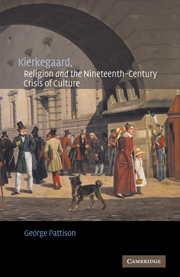Book contents
- Frontmatter
- Contents
- Preface
- Acknowledgements
- List of abbreviations
- 1 The sublime, the city and the present age
- 2 Kierkegaard and the world of the feuilletons
- 3 The present age: the age of the city
- 4 ‘Cosmopolitan faces’
- 5 Food for thought
- 6 A literary scandal
- 7 The reception of Either/Or
- 8 New Year's Day
- 9 Kierkegaard and the nineteenth century (1) Manet
- 10 Kierkegaard and the nineteenth century (2) Dostoevsky
- 11 Learning to read the signs of the times
- Bibliography
- Index
1 - The sublime, the city and the present age
Published online by Cambridge University Press: 22 September 2009
- Frontmatter
- Contents
- Preface
- Acknowledgements
- List of abbreviations
- 1 The sublime, the city and the present age
- 2 Kierkegaard and the world of the feuilletons
- 3 The present age: the age of the city
- 4 ‘Cosmopolitan faces’
- 5 Food for thought
- 6 A literary scandal
- 7 The reception of Either/Or
- 8 New Year's Day
- 9 Kierkegaard and the nineteenth century (1) Manet
- 10 Kierkegaard and the nineteenth century (2) Dostoevsky
- 11 Learning to read the signs of the times
- Bibliography
- Index
Summary
The concept of the sublime is, perhaps necessarily, elusive, a concept that resists incorporation into the domain of clear and distinct ideas, if ‘concept’ there is or can be at all in this case. What is sublime is what unsettles, what cannot settle or be settled: a realm of experiences, representations and ideas that is turbulent and unmanageable. Such a realm may be figured in the Alpine landscape that the eighteenth and early nineteenth century saw as the wreckage of an earlier creation, or in storm and battle, perennial paradigms of sublime experience. Equally, if paradoxically, the sublime resonates with the daily life-experience of the modern city-dweller. Indeed, it has been argued that there is an intrinsic connection between the rise of the modern city and the aesthetics of the sublime that developed in the latter part of the eighteenth century. For the city irreversibly redefined the individual's relation to the environment. This had to do not only with the way in which the new, expanding cities (beginning with London) overran their medieval walls, were reconstructed in an architecture that reflected the scale and style of imperial ambitions, and so overwhelmed the individual by virtue of their size (and magnitude, to anticipate, provided Kant with one of the foci of his discussion of the sublime).
- Type
- Chapter
- Information
- Publisher: Cambridge University PressPrint publication year: 2002



